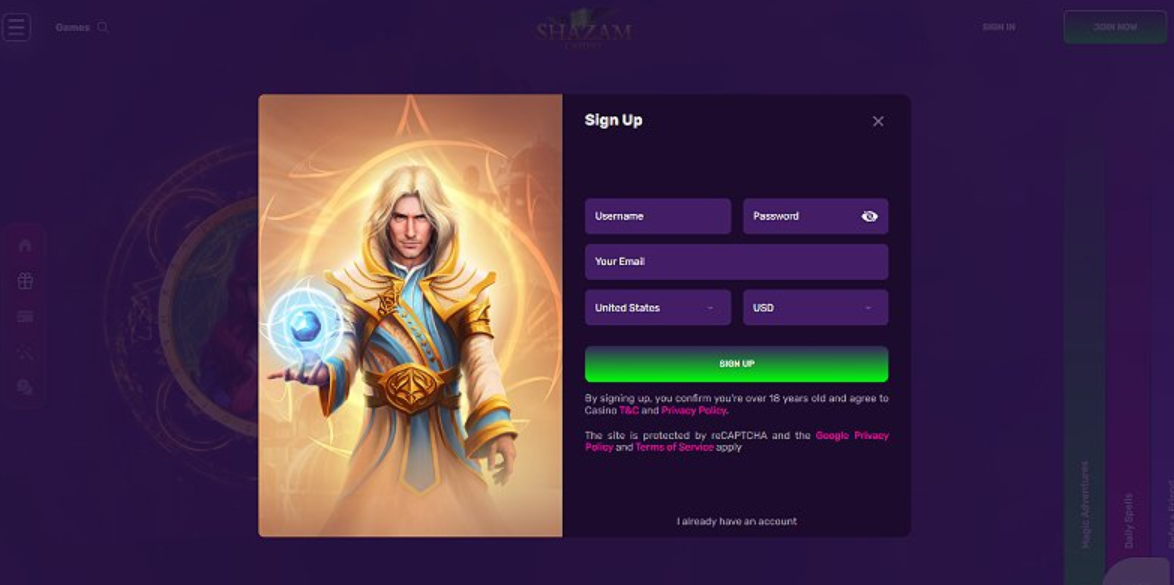Logging into Shazam online casino: secure login, quick start, and zero stress

This article is your step-by-step guide to securely logging into your Shazam account from the US: you will learn about the types of authorization, security, common mistakes, and how to fix them. If you want to go straight to the authorization form, use the official address: https://shazamcasino.com/login — use it as a reference.
What happens when you log in correctly 🔑
When you enter your username and password, the system verifies the data, creates a secure session, and links it to your device and browser. If two-factor authentication (2FA) is enabled, a one-time code from the generator app is also required. This minimizes the risk of unauthorized access even if your password is compromised.
Why it’s important to keep control of your devices 🖥️📱
Your personal account stores your login history and active sessions. Regularly close unnecessary sessions, especially after logging in from a work computer or smartphone that other people have access to. This way, you “cut off” unnecessary entry points.
Four quick security checks ✅
- The “lock” icon in the address bar and the correct domain.
- A unique long password (14+ characters).
- 2FA enabled via the app (not SMS, if there is a choice).
- An updated browser and suspicious extensions disabled.
Where is it more convenient, and where is it more reliable⚖️
Password-only login is fast but more vulnerable. The “password + 2FA” combination takes 5–10 seconds longer, but significantly increases security. Saving your device as trusted saves time on subsequent logins, but only use this on your personal gadget.
Authorization methods and security level
| Login method | Speed | Convenience when traveling | Security level | When to use |
|---|---|---|---|---|
| Username + password | ★★★★★ | ★★★★★ | ★★☆☆☆ | Only on a 100% personal device and for frequent short sessions |
| Login + password + 2FA (TOTP) | ★★★★☆ | ★★★★☆ | ★★★★★ | Recommended for everyone; optimal standard |
| Trusted device | ★★★★★ | ★★★★☆ | ★★★☆☆ | On your home PC/personal smartphone with screen lock |
| Temporary one-time backup code | ★★☆☆☆ | ★★★☆☆ | ★★★★☆ | Only if you lose access to 2FA and before re-binding |
Step-by-step instructions for logging in the US 🧭
- Open the official address in your browser and check for the “padlock” (TLS).
- Enter your email and password. If you forgot your password, click “Forgot password.”
- Confirm 2FA from the app (Google Authenticator, Authy, etc.).
- Select “Remember me” only on a personal device with PIN/Face/Touch protection.
- Check the welcome screen: menu sections, balance, notifications.
- Go to Profile → Security, make sure 2FA is enabled and notifications are active.
- Close third-party tabs to avoid accidental clicks and phishing.
Geolocation, age, and data matching 🇺🇸
To access sections, you need to confirm your geolocation (allow your browser) and be 21+. The name in the payment method must match the name in your profile: this will speed up KYC and future withdrawals.
Diagnosis by symptoms 🧯
- “Incorrect password.” Reset your password and check your keyboard layout/caps lock.
- “2FA code does not match.” Synchronize the time on your phone, update the code, check the time zone.
- “IP/geo-block.” Enable geolocation, disable VPN, log in again.
- “Session error.” Clear your cache/cookies, restart your browser, try another one.
Common login issues and quick fixes
| Symptom | Possible cause | What to do |
|---|---|---|
| Password does not match | Typo/caps lock/old password | Reset password, set 14–20 characters, save in manager |
| 2FA code not accepted | Time discrepancy, incorrect account in the app | Synchronize time, re-link 2FA, use backup code |
| Geo-blocking | Geolocation access denied/VPN enabled | Enable geolocation, disable VPN, refresh the page |
| Session crashes | Cookie/extension conflict | Clear cache/cookies, launch a “clean” browser profile |
| Slow loading | Network/browser/firewall | Check your internet connection, disable track blockers for the domain, update your browser |
Types and recommendations: digital login hygiene
- Unique password for Shazam only.
- 2FA app instead of SMS, when available.
- Auto-logout from public/work devices.
- Login notifications via email/SMS — always enabled.
- Prohibit auto-saving passwords in “foreign” browsers.
- Password manager with a strong master phrase.
- Public Wi-Fi ≠ payments. Only mobile internet/private network.
- Weekly check of login logs in your profile.
Mobile vs. desktop login
What to choose today — a quick reminder 📱🖥️
- Mobile login is faster and more convenient for short sessions; biometrics speeds up authorization.
- Desktop provides a better overview and fewer input errors; convenient for profile/limit settings. The ideal solution is to combine the two: quick logins from your smartphone and fine-tuning on your PC.
Quotes/statements: expert opinions
“Secure login is not paranoia, it’s time-saving. Set up 2FA and notifications once, and every subsequent login will be stress-free.”
— Digital security expert 🧠
“Remember this simple rule: a trusted device is only one that has a screen lock. Anything else is a compromise.”
— Session management analyst 🔐
Pros and cons of authorization approaches
Objectively good ✅
- 2FA dramatically reduces the risk of hacking, even if your password is leaked.
- Trusted devices save time on daily logins.
- Alerts allow you to respond to suspicious activity instantly.
- A password manager makes it easier to comply with the “long and unique” rule.
What to watch out for ❌
- The 2FA app is another device and backup codes (responsibility to store).
- “Remember me” on someone else’s PC — risk of compromise.
- SMS-2FA is vulnerable to SIM swapping, TOTP app is better.
- Public Wi-Fi increases the chances of data interception.
Steps to secure login 🔐
- In your profile, open Security → Two-Factor Authentication.
- Scan the QR code with the 2FA app.
- Enter a one-time code to link.
- Save backup codes offline (on paper/in a safe).
- Enable login and password change notifications.
- Add a device as trusted only if it is personally yours.
- Test logging out/in again to make sure everything works.
Why verification speeds up access and payments 🧾
KYC is the confirmation of your identity and payment details. Complete it in advance: in case of unusual activity, the system may request re-login and additional verification. Prepared documents reduce waiting time and lower the chance of “freezes” during cashout.
Top 5 useful habits
- ✅ 2FA via the app + backup codes.
- ✅ Password manager and long unique combinations.
- ✅ Weekly check of login history.
- ✅ Auto-logout on “foreign” devices.
- ✅ VPN ban during login and payments (for correct geolocation verification).
Top 5 mistakes to avoid
- ❌ Reusing the same password on different sites.
- ❌ Saving your password in the browser of a shared computer.
- ❌ Trusting public Wi-Fi for authorization and payments.
- ❌ Putting off 2FA “until later.”
- ❌ Ignoring login notification emails.
Quick tips
Before logging in
Check the domain, the padlock, disable VPN, and prepare 2FA.
During login
Do not copy passwords from suspicious applications, and be careful with autocomplete.
After logging in
Go to Security, check active sessions, and close any unnecessary ones.
If something goes wrong
Change your password, restart 2FA, log out of all devices, and contact support.
How to choose your daily balance ⏱️ 🛡️
- Maximum speed: password + remember me (only on your personal phone with Face/Touch ID).
- Smart middle ground: password + 2FA, remember me on personal devices.
- Strict security: password + 2FA without remember me, login on request — suitable for rare but important sessions.
Secure login is a habit that pays off
What to take with you today 🧾
- Check the domain and the “lock.”
- Enable 2FA and save backup codes offline.
- Use a password manager.
- Login alerts are a must-have.
- On other people’s devices, don’t use “Remember me.”
- Once a week, check your active sessions.
“Reliability is not complexity, but repeatability. The same 5 simple steps every time you log in give you peace of mind and protection.” ✨
Play consciously and safely: proper authorization is the first layer of your protection and the basis for a comfortable session on Shazam. 🎰🔐💡
Frequently asked questions
Why do I need 2FA if my password is “very strong”?
Because leaks and phishing don’t only happen because of “weak” passwords. 2FA blocks login even if the password is known.
Can I store backup codes in the cloud?
Yes, if the cloud is protected by a separate strong passphrase and 2FA. It is safer to keep a copy offline.
Why does the system sometimes ask me to log in again?
The session timeout has expired, the IP/geo has changed, or important security settings have been updated.
